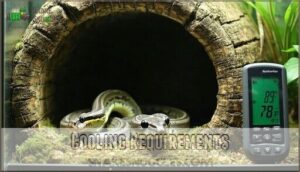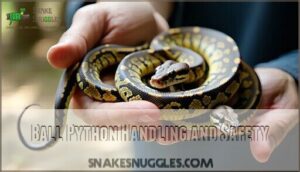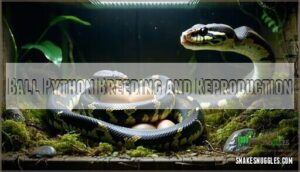This site is supported by our readers. We may earn a commission, at no cost to you, if you purchase through links.

You’ll need a secure 40-gallon enclosure with proper temperature gradient (75-95°F) and moderate humidity (50-60%). They’re relatively small constrictors, typically reaching 3-5 feet, with lifespans of 20-30 years—quite the commitment!
Feed your python appropriately-sized frozen-thawed rodents every 7-14 days, and handle them gently for short periods after they’ve acclimated to their new home. Like any pet, these "pet rocks" have their quirks—they’ll sometimes fast for weeks or curl into tight defensive balls when stressed.
Proper setup prevents most common health issues.
Table Of Contents
- Key Takeaways
- Ball Python Basics
- Choosing The Right Enclosure
- Ball Python Heating and Humidity
- Ball Python Diet and Feeding
- Ball Python Handling and Safety
- Ball Python Health and Hygiene
- Ball Python Shedding and Molting
- Ball Python Behavior and Bonding
- Ball Python Breeding and Reproduction
- Ball Python Care Tips and Reminders
- Frequently Asked Questions (FAQs)
- What is a ball python beginner guide?
- How to develop a Bouncing Ball Game in Python?
- What is a ball python Care Guide?
- Are ball pythons easy to care for?
- What do I need to know before getting a ball python?
- Will a ball python strike at you?
- Is taking care of a ball python easy?
- What is a ball python?
- How to handle a ball python?
- Are ball pythons good first snakes?
- Conclusion
Key Takeaways
- You’ll need a secure 40-gallon enclosure with a proper temperature gradient (75-95°F) and moderate humidity (50-60%) to keep your ball python healthy and comfortable.
- Feed your python appropriately-sized frozen-thawed rodents every 7-14 days, adjusting frequency based on age (juveniles eat weekly, adults every 10-14 days).
- You’ll develop trust with your ball python through consistent, gentle handling sessions of 15-20 minutes, 2-3 times weekly, avoiding handling during feeding times or shedding periods.
- Ball pythons typically live 20-30 years with proper care, making them a significant commitment that rewards you with a docile companion.
Ball Python Basics
Ball pythons are non-venomous, nocturnal snakes native to Africa, known for their docile nature and relatively small size compared to other pythons.
They’re an ideal choice for beginners due to their manageable care needs, unique patterns, and long lifespan.
Ball Python Characteristics
Ball pythons (Python regius) are known for their friendly snake temperament, unique physical traits, and stunning genetic diversity.
With beautiful color morphs and manageable snake size, they’re an ideal beginner’s snake. Their spurs, small vestigial limbs, add to their charm.
They’re low-maintenance and favor cozy spaces, making snake handling easier.
- Calm and docile nature
- Wide range of gorgeous color morphs
- Manageable size for handling
- Simple care and diet needs
- Gentle, introverted personality
They possess a combination of desirable traits, including a calm and docile nature and manageable size, which make them a popular choice for many snake enthusiasts.
Ball Python Lifespan
If you’re considering a pet with commitment, a ball python is perfect.
In captivity, they can outlive their wild counterparts, reaching 20-30 years.
Factors affecting their lifespan include diet, stress, and care quality.
Extending lifespan? Prioritize proper snake care—like consistent feeding and habitat setup.
Common causes of shorter lives often trace back to neglect.
With great care, these snakes thrive impressively!
Ball Python Size
Reaching an adult size of 3 to 4 feet, ball pythons are perfect for beginners. Females often grow slightly larger than males, showcasing sexual dimorphism.
Perfect for beginners, ball pythons reach an adult size of 3–4 feet, with females typically growing slightly larger than males.
Captive growth depends on size genetics and ball python care. Enclosure size is vital—too small, and your snake’s health may suffer.
Proper feeding prevents malnutrition, ensuring steady development. With proper care, their manageable snake size makes them ideal companions.
Choosing The Right Enclosure
When choosing an enclosure for your ball python, focus on providing enough space, proper ventilation, and a secure lid to prevent escapes.
The right setup helps your snake thrive by maintaining ideal temperature, humidity, and a sense of safety.
Ball Python Tank Size
Choosing the right snake enclosure is key to good ball python care.
Tanks should match your python’s growth:
- Hatchlings thrive in minimum dimensions of a snug 10-gallon tank.
- Juveniles need more room; upgrade to 20 gallons.
- Adults require a 30-40 gallon setup for comfort.
Remember, more vertical space isn’t necessary, as ball pythons aren’t climbers.
- Make certain materials retain heat and humidity (e.g., glass or plastic).
- Plan for just one snake per tank.
- Oversized tanks can stress beginner snakes.
Many owners buy specialized python enclosures for their pets.
Type of Ball Python Tanks
Glass terrariums offer visibility but need tank modifications for humidity and snake comfort.
Plastic enclosures are lightweight and easy to clean, perfect for beginner snake owners.
Wooden vivariums provide warmth and stability but demand careful maintenance.
Rack systems save space, ideal for breeders.
Custom builds let you design a reptile habitat, but they require skill and time.
Each snake enclosure option supports proper ball python care with the right terrarium setup strategy.
Ideal Temperature Gradient
Creating a proper thermal gradient is vital for ball python care.
Set up a basking spot on the warm side, ranging 88-92°F, and maintain a cool side at 75-80°F.
Use heat sources like heat lamps or mats, paired with a thermostat for precise temperature regulation.
Maintaining consistent warmth at night is also key for their well-being.
Regularly monitor your terrarium setup to confirm the gradient supports natural behavior, keeping your python comfortable and healthy.
Ideal Humidity Levels
Humidity plays a big role in your snake’s health and comfort.
For ball pythons, aim for 50%-60% humidity to prevent shedding problems and keep them hydrated. Use a hygrometer to monitor snake humidity effectively.
If levels drop, try enclosure misting or adding moss in their hide. Combining humidity control with proper temperature regulation (cool end: 80-85°F, warm end: 90-95°F) keeps everything balanced.
Remember, too much or too little moisture can lead to issues, so keep an eye on it! Your python relies on you to master these simple humidity solutions.
Substrate
Think of substrates as your ball python’s cozy rug—essential for comfort, cleanliness, and encouraging natural behaviors like digging.
The right substrate makes a big difference in retaining humidity while being safe and easy to maintain. Cypress mulch is a superstar option, thanks to its moisture retention and ability to prevent mold.
For simpler upkeep, consider aspen shavings or coconut fiber blends. Avoid sand, cedar, and pine, which can harm your snake’s health.
Many keepers purchase appropriate substrate options online. Always clean frequently to keep bacteria at bay.
With the right substrate in your ball python setup, you’ll recreate a slice of their natural world, perfect for beginner reptiles and seasoned keepers alike.
Ball Python Heating and Humidity
To keep your ball python healthy, you’ll need to create an enclosure with proper heating and humidity that mimics its natural habitat.
By maintaining the right temperature gradient and moisture levels, you’ll guarantee your snake stays comfortable, sheds properly, and avoids common health issues.
Heating Requirements
When setting up heating for your ball python, creating a temperature gradient is essential.
Aim for a warm side at 88-92°F and a cool side around 76-80°F. Use heat sources like mats, ceramic heaters, or lamps, but skip heat rocks—they’re unsafe!
Always regulate heat with a thermostat for precise control. Choosing the right thermostat is important for maintaining consistent temperatures.
Place heat mats under the enclosure, never in direct contact with your snake. Monitoring with thermometers guarantees your python enjoys its basking spot and stays cozy, night and day.
Cooling Requirements
Keeping your ball python cool isn’t just about letting them chill—it’s essential snake care for beginners. Avoid overheating risks by maintaining the cool side at 76-80°F.
Proper ventilation and strategic cooling methods, like quality substrates, can make summer solutions easier. During brumation periods, make certain temperatures don’t drop too low.
A secure enclosure is necessary to prevent any escapes.
Here’s how to manage cooling effectively:
- Pick a night drop thermostat.
- Avoid direct sunlight exposure.
- Maintain steady airflow.
- Use infrared thermometers.
- Provide shaded hide spots.
Humidity Levels
When managing snake humidity, aim for 55-60%.
Too damp? Risk shedding problems.
Too dry? Hydration needs suffer.
Use a reliable hygrometer for humidity monitoring and mist the enclosure regularly.
Add humidity boxes with moist moss to keep your python comfy.
Snake care for beginners is simpler when tools like hygrometers are calibrated.
A well-monitored habitat keeps shedding smooth.
Maintaining a Thermal Gradient
Your ball python’s warmth is all about balance. A proper thermal gradient supports natural basking behavior and digestion. Keep the warm side (88-94°F) cozy with a reliable heat source, like an undertank heating mat or ceramic heater, and the cool side (76-80°F) invigorating.
Use thermometers and thermostats for gradient monitoring, ensuring comfort.
- Position hides strategically on both sides for temperature variety.
- Watch for seasonal adjustments to keep consistency year-round.
- Avoid hotspots that can burn your snake.
- Stick to thermostat-regulated heating to simplify adjustments.
Think stable, not sweltering!
Ball Python Diet and Feeding
Feeding your ball python is simpler than you might think, but it’s essential to provide the right type of prey at the right intervals.
Their diet consists of whole prey like mice or rats, offering all the nutrients they need to stay healthy.
What Does a Ball Python Eat?
Your ball python thrives on a whole-prey diet of appropriately sized frozen-thawed rodents, like mice or rats.
Thaw food safely to room temperature before feeding. Hatchlings eat every 5-7 days, while adults require less frequent meals (7-14 days).
Avoid overfeeding to prevent obesity risks. Use a separate tank for feeding to reduce stress and keep cleanup simple.
Components of a Ball Python Diet
A healthy snake diet revolves around whole prey, mainly mice and rats.
Choose rodents sized to match the snake’s girth—no bigger!
Hatchlings thrive on smaller rodents, while adults handle larger prey.
Feeding frequency? Juveniles eat weekly; adults usually every 10-14 days.
Preferring frozen-thawed prey reduces injury risks and is easier to manage—just thaw properly in warm water to mimic fresh kill.
Supplements aren’t necessary if the snake diet consists of well-raised whole prey.
Overfeeding leads to obesity risks, so watch those portions carefully.
Feeding Techniques
To simplify snake feeding, pick prey matching your python’s widest part.
Thaw frozen mice or rodents till they’re room temperature—feeding cold snacks isn’t comfy. Use tongs for safety, especially during live feeding.
Stick to the right feeding frequency, avoiding overfeeding. If refusal happens, check for shedding or stress.
A patient, proper snake diet keeps your python healthy and thriving.
Ball Python Handling and Safety
Handling your ball python is an important part of building trust while keeping both you and your pet safe.
By understanding their body language and following basic safety steps, you’ll create a stress-free experience for both of you.
Handling Advice
Your ball python isn’t just a pet—it’s a cautious companion with unique needs.
Focus on safe handling by starting slow; let it gradually adjust to your touch. Pay attention to handling frequency; aim for short sessions every few days.
Watch for behavior cues like tight curls (nervousness) or slow movements (calm). Avoid bites by steering clear during feeding or shedding.
For kids, supervision is key, teaching them gentle handling. Consistency builds trust, making your snake a relaxed, happy companion.
Safety Precautions
Handling your ball python safely is key to a great experience.
Take steps to guarantee their enclosure is escape-proof, and always focus on proper handling techniques.
Here are essential precautions:
- Wash your hands before and after handling for hygiene.
- Use a snake hook to prevent surprises.
- Support their body with both hands for security.
- Avoid feeding times to reduce stress.
- Always secure the enclosure after interaction.
Minimizing The Risk of a Ball Python Bite
Calm handling minimizes the chance of a bite. Always wash your hands to avoid food scents, and approach your snake slowly.
Reading body language is vital—if it curls or hisses, give space. Safe handling tools, like hooks, can help.
Gradual acclimation builds trust, while respecting boundaries guarantees comfort. Avoiding food response by feeding outside the enclosure keeps your ball python more predictable and less defensive, ensuring calm and predictable behavior.
Ball Python Health and Hygiene
Keeping your ball python healthy and clean is essential for its long, happy life. From maintaining proper humidity to preventing common illnesses, paying attention to hygiene makes a big difference.
Common Health Issues
Keeping your ball python healthy means spotting problems early.
Watch for common issues like mites and scale rot, which thrive in dirty enclosures. Respiratory infections result from improper temperatures, while dehydration symptoms stem from low humidity.
Overfeeding leads to obesity risks, so a balanced diet is key. Always quarantine new snakes to avoid spreading illnesses, and remember: regular health checks prevent serious snake woes.
- Key issues:
- Parasite prevention.
- Respiratory infection monitoring.
- Dehydration symptoms.
- Obesity risks.
- Quarantine protocols.
Inclusion Body Disease (IBD)
Spotting strange behavior in your ball python, like head tremors or "stargazing," might point to Inclusion Body Disease (IBD), a severe snake illness.
IBD transmission happens through contact with infected snakes or poor hygiene. Diagnosing IBD involves blood tests or tissue samples via your veterinarian.
Sadly, managing IBD focuses only on supportive care since no cure exists. Regular cleaning, separating new additions, and early vet visits are your best defense.
| Symptom | Prevention Tip | Diagnosis Tool |
|---|---|---|
| Neurological Issues | Sanitize enclosure | Blood Testing |
| Weight Loss | Quarantine newcomers | Tissue Sampling |
| Respiratory Problems | Disinfect regularly | Vet Examination |
Dysecdysis
Shedding problems, like dysecdysis, can make your ball python’s skin look patchy or cloudy.
Often caused by low humidity or stress, it’s manageable with thoughtful snake care.
Humidity’s role is critical—maintain levels at 50–60% and provide a damp hide.
Here are steps to prevent and treat it:
- Mist the enclosure regularly.
- Provide a proper temperature gradient.
- Soak the snake if shedding persists.
- Gently remove stuck skin.
- Address underlying causes promptly to ensure your snake’s health and well-being, and prevent future shedding problems.
Pneumonia
Pneumonia is a serious respiratory infection every ball python owner should know about.
Pneumonia causes include low humidity or improper temperatures, which weaken your snake’s health.
Recognizing symptoms like open-mouth breathing or wheezing is vital. Prompt veterinary care and antibiotics are often lifesavers.
To prevent future snake illnesses, maintain proper habitat conditions with a warm, humid environment. A healthy setup keeps snake health on track and pneumonia away.
Stomatitis
Stomatitis, or mouth rot, is a bacterial infection that affects your ball python’s gums, mouth, and jaw.
Causes include stress, poor hygiene, or injuries.
Symptoms like swollen gums or bubbling drool mean trouble. Talk to a vet ASAP if you notice these signs.
To prevent stomatitis:
- Clean the water bowl daily
- Check your snake for injuries
- Provide stable temperatures
- Reduce stress in the enclosure
Cleaning The Habitat
Keeping your ball python healthy starts with a clean home. Regularly clean and disinfect the enclosure to prevent mold, bacteria, and odors. Use snake care cleaning supplies like reptile-safe disinfectants for climbing items and walls.
Replace soiled substrates promptly and sanitize water bowls to guarantee proper water sanitation. Prioritize waste removal frequently to maintain hygiene. Always inspect for mold prevention and replace damp spots.
| Task | Frequency |
|---|---|
| Snake substrate check | Daily |
| Waste removal | Every 1-2 days |
| Water sanitation | Weekly |
| Disinfecting enclosure | Weekly |
| Deep clean | Monthly |
Your snake will thank you through calm behavior!
Daily Maintenance
Daily ball python care doesn’t take long but makes a big difference! Here’s a simple guide:
- Water Refresh: Change the water daily to keep it fresh and clean.
- Spot Cleaning: Remove waste or soiled substrate.
- Temperature Checks: Verify warm and cool zones are correct.
- Humidity Control: Maintain levels between 50-60%.
- Quick Habitat Scan: Look for anything unusual in their setup.
Easy, right?
Weekly Maintenance
How’s your snake care routine going? Weekly tasks keep things smooth!
Here’s what to do:
- Enclosure Spot-Clean: Remove waste and refresh used substrate.
- Water Refresh: Replace the water for hydration and soaking.
- Equipment Check: Inspect for damage, maintain snake temperature, and verify humidity control.
These steps guarantee a clean, cozy environment for your ball python!
As Needed
Regarding as-needed ball python care, stay alert for any unusual behavior, irregular shedding, or skin issues—these might need emergency care or a veterinary visit.
If you’re traveling, update their habitat for safety.
Long-term planning, including end-of-life considerations, is part of responsible snake care.
Master snake care essentials, like escape prevention and weight monitoring, to keep your snake thriving.
This snake care guide for beginners makes it all manageable!
Ball Python Shedding and Molting
Shedding is a natural process that lets your ball python grow and maintain healthy skin, but it can sometimes seem mysterious or even tricky to manage.
Understanding the signs of shedding and knowing how to assist when needed will keep your snake comfortable and stress-free.
Why Ball Pythons Shed
Just like humans outgrow their clothes, your ball python sheds its skin through a process called ecdysis. This natural occurrence happens for several essential reasons:
- Growth – Your python needs new skin to accommodate its increasing size
- Healing – Shedding repairs damaged or scarred tissue
- Parasite removal – Fresh skin helps eliminate external parasites
- Hydration regulation – New skin manages moisture better
- General renewal – The process refreshes worn scales
Proper humidity helps prevent shedding problems and dysecdysis.
How to Identify Shedding
Your ball python’s shedding process has several telltale signs to watch for. When scales become dull and lose their luster, or eyes turn bluish and cloudy ("blue phase"), shedding is imminent.
You might notice behavior changes like decreased appetite or increased hiding. Monitor skin dullness and eye caps carefully.
Maintaining proper humidity (70-80%) prevents shedding problems. Regular inspection helps track your snake’s shedding frequency and guarantees healthy, complete sheds, ensuring a smooth process with regular inspection.
How to Assist With Shedding
During shedding, your ball python requires extra care.
Maintain 70-80% humidity and provide a moist hide box to prevent dysecdysis (stuck shed).
If problems occur, never pull at retained skin—instead, offer a 20-minute lukewarm bath.
Gently rub stubborn patches with a damp washcloth, paying special attention to eye caps and tail tips.
Proper handling during this sensitive time minimizes stress and guarantees complete shedding frequency with the right approach, including a gentle touch to prevent dysecdysis.
Ball Python Behavior and Bonding
You’ll find that ball pythons can form meaningful bonds with their owners through regular, gentle handling and consistent interaction.
Understanding their body language, which includes slow movements and tongue flicking when calm versus balling up when stressed, will help you build trust with your scaly companion.
Ball Python Behavior
Understanding your ball python’s behavior requires careful observation.
These nocturnal creatures display fascinating patterns when comfortable in their environment.
- Your snake’s defensive posturing reveals its stress levels
- Tongue flicking indicates curiosity and environmental exploration
- Regular shedding behavior signals proper health conditions
- Captive adaptations show how well they’re adjusting to life with you
Watch for these clues—when your pet snake curls into a ball, it’s feeling threatened, not cuddly.
Their calm demeanor normally includes slow, deliberate movements with occasional investigative tongue flicks.
Bonding With Your Ball Python
While ball pythons aren’t typically viewed as affectionate pets, you can develop meaningful trust with your snake companion.
Start by allowing your pet snake time to adjust to its environment before attempting handling. When your ball python seems comfortable, begin with short, gentle sessions (5-10 minutes) every few days.
Reading behavior cues like relaxed muscles indicates reduced stress. Genetics play a role, as some morphs are prone to neurological issues.
Consistent, positive reinforcement through respectful handling frequency helps build a strong foundation for trust building over time, which is crucial for a harmonious relationship with your ball python, and this is achieved through gentle sessions and positive reinforcement.
Handling Tips
Now that you’ve built trust with your ball python, let’s explore proper handling techniques.
When approaching your snake, move confidently but slowly. Hold your python with both hands, supporting its body weight evenly.
Limit handling sessions to 15-20 minutes, 2-3 times weekly. Always read your snake’s temperament—if it’s tense or hissing, postpone handling.
Never handle immediately after feeding, and supervise children closely during interactions.
Ball Python Breeding and Reproduction
You’ll need to understand the reproductive cycle of ball pythons before attempting to breed these fascinating creatures, which typically occurs when they reach 3-5 years of age and proper weight thresholds.
Breeding involves introducing males to females during the winter breeding season, followed by a 30-45 day gestation period that concludes with the female laying 2-10 eggs.
These eggs require specific incubation conditions for successful hatching.
Ball Python Breeding
Many experienced ball python owners eventually consider breeding.
The breeding season typically spans September through March, requiring careful preparation.
You’ll need specialized equipment like incubators for the 4-10 egg clutch sizes.
Focus on ethical breeding practices that prioritize genetic diversity and health over rare morphs.
Understanding snake genetics helps predict offspring traits.
It’s a rewarding challenge that demands research, patience, and responsibility—like playing scientific matchmaker for your scaled companions!
Ball Python Reproduction
After successful mating comes the fascinating reproductive process of ball pythons. The breeding season typically runs from September through March when temperature drops stimulate breeding behavior.
During reproduction, ball pythons follow a predictable pattern:
- Males track females using pheromone signals and heat detection
- Courtship involves gentle chin rubbing and body alignment
- Mating may last 12-24 hours with multiple "cloacal locks"
- Females store sperm for weeks before fertilizing eggs
A female ball python can produce a clutch size of 3-11 eggs depending on her health and size. Most captive snakes produce one clutch annually, though some genetic morphs may affect reproduction rates.
Ball Python Egg-Laying
After successful breeding, female ball pythons lay 4-10 eggs in a clutch, usually when they’re 3-5 years old.
You’ll observe your snake protectively coiling around her eggs – maternal instinct in action!
Incubation requires consistent 88-90°F temperatures and high humidity levels for about 60 days.
Watch for slight "dimpling" as hatching approaches.
Fertility issues occasionally occur in captive breeding, so don’t be discouraged if your first attempt isn’t successful.
Proper hatchling care begins before they even emerge.
Ball Python Care Tips and Reminders
You’ll need to monitor your ball python’s habitat daily, just as carefully as you’d check your own home’s thermostat, to verify proper temperature gradients and humidity levels between 50-60%.
Regular handling sessions of 15-20 minutes, along with consistent feeding schedules and thorough habitat cleaning, will help your snake thrive throughout its potential 30-year lifespan.
Tips for Ball Python Owners
Now that you’ve mastered breeding, let’s focus on daily care success.
Here are five proven tips for ball python owners:
- Monitor behavior daily – sluggishness might indicate health issues
- Maintain proper hydration by checking water bowls and humidity levels
- Add enrichment ideas like climbing branches or new hides monthly
- Practice safe handling techniques, supporting your snake’s body fully
- Learn signs of illness early – unusual postures or respiratory sounds require attention
Remember, consistent snake care basics prevent stress and create a thriving pet that may live 30+ years!
Common Mistakes to Avoid
When caring for your ball python, avoid these critical mistakes that can impact their health.
Don’t overfeed—one appropriately-sized meal every 7-14 days is sufficient. Choose proper substrates like cypress mulch instead of sand or cedar, which can cause respiratory issues.
Handle your snake with gentle support, never grabbing from above. Ignoring humidity (maintain 55-60%) or providing inadequate heating can lead to serious health problems.
Regular temperature checks and proper hide spots are essential for your serpent’s wellbeing, ensuring a healthy environment with adequate hide spots.
Ball Python Care Reminders
While avoiding common mistakes puts you ahead, consistently implementing these ball python care reminders guarantees long-term success:
- Monitor temperature and humidity daily – fluctuations can stress your snake and lead to health issues
- Check enclosure security weekly – ball pythons are escape artists when motivated
- Limit handling to 1-2 times weekly for 15 minutes maximum
- Schedule veterinary checkups annually with a reptile specialist
- Keep detailed records of feedings, sheds, and weight changes
Your ball python’s health depends on these consistent routines.
Remember to provide appropriate hide boxes to reduce stress.
Think of yourself as a caretaker of a living treasure – one that’ll reward your diligence with fascinating behavior and potentially decades of companionship.
Frequently Asked Questions (FAQs)
What is a ball python beginner guide?
Taking the plunge into ball python ownership?
You’ll need a thorough guide covering habitat setup, temperature control, feeding schedules, handling techniques, and health monitoring.
This is essential for your new reptilian friend’s 20-30 year lifespan.
How to develop a Bouncing Ball Game in Python?
To create a bouncing ball game in Python, you’ll need Pygame.
Import it, set up a screen, define ball physics (velocity, gravity), handle collisions with boundaries.
Implement user controls for interaction.
What is a ball python Care Guide?
Ball pythons require a proper enclosure with heat gradient (75-90°F), humidity control (50-60%).
They also need weekly feedings of appropriately-sized rodents, and regular handling.
With good care, these docile reptiles can live 20-30 years.
Are ball pythons easy to care for?
Yes, ball pythons are easy to care for.
They’re docile, low-maintenance, and thrive with minimal handling.
You’ll appreciate their simple habitat requirements, straightforward feeding schedule, and calm temperament—making them perfect for beginners entering the reptile world.
What do I need to know before getting a ball python?
You’ll need proper housing with temperature control (75-95°F), humidity monitoring (50-60%), two hiding spots, appropriate substrate, and a feeding plan.
Consider their 20-30 year lifespan and space requirements before committing.
Will a ball python strike at you?
Despite their intimidating appearance, ball pythons rarely strike aggressively.
They’re typically docile creatures who’ll only bite if they’re stressed, mishandled, or mistake your hand for food.
Regular, gentle handling reduces this risk substantially, making them a great pet for those who handle them with care.
Is taking care of a ball python easy?
Caring for a ball python is relatively easy.
You’ll need proper heating, humidity control, appropriate enclosure size, and consistent feeding schedule.
With these basics covered, they’re low-maintenance pets that can live 20-30 years.
What is a ball python?
Ball pythons are non-venomous snakes native to western and central Africa.
They’re named for their defensive habit of curling into a ball when threatened.
You’ll find they’re typically 3-5 feet long with a 20-30 year lifespan.
How to handle a ball python?
Support your python’s body when handling, keeping movements slow and deliberate. Wash your hands before and after. You’ll want to avoid handling during feeding times or when they’re shedding.
Are ball pythons good first snakes?
Holy smokes, yes! You’ll find ball pythons are excellent first snakes.
They’re docile, manageable in size (3-5 feet), and have simple care requirements.
Their long lifespan (20-30 years) means you’ll have a lasting companion.
Conclusion
Becoming a ball python parent provides profound rewards with proper preparation.
These docile reptiles make outstanding first-time pets when you commit to their specialized needs.
Remember that your ball python for beginners journey requires patience—they’ll need time to acclimate to handling and may occasionally refuse meals.
With consistent care, appropriate habitat maintenance, and gentle interaction, you’ll develop a fascinating relationship with your serpentine companion that can last decades.
Your ball python’s health and happiness depend entirely on your dedicated stewardship.
- https://www.petmd.com/reptile/ball-python-care-sheet
- https://community.morphmarket.com/t/advice-for-a-beginner/36834
- https://www.happydragons.com/buying-guides/ball-python-starter-buying-guide
- https://www.reddit.com/r/ballpython/comments/br1ufq/megathread_protips_for_beginners/
- https://reptifiles.com/ball-python-care-guide/






















